After the long drive the day before, everyone in the group was raring to go the next morning. The weather forecast was mixed, but we set off for the short thirty minute drive to the hillsides to the north of Demonte, where Scarce Fritillary (
Euphodryas maturna) has its only colonies in Italy.
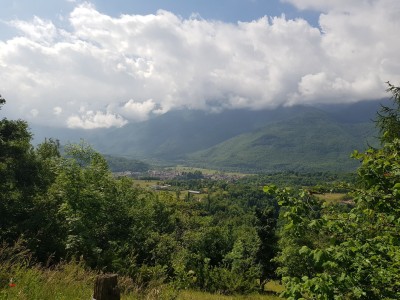
- Views from our first site
There were decent sunny spells at our first site, but it became clear straight away just how late the 2024 season was for butterflies. Large White (
Pieris brassicae) was by far the commonest butterfly, and there were good numbers of fresh-looking Orange Tip (
Anthocharis cardimines). Also common were Adonis Blue (
Polyommatus bellargus) and Heath Fritillary (
Melitaea athalia), individuals of both species looking mint fresh. One of the guests also spotted a Sooty Copper (
Lycaena tityrus), which turned out to be one of only three sightings all week of this normally common species.
A number of us also spent some time studying some distant photos of either a Large Wall Brown (
Lasiommata maera) or Northern Wall Brown (
Lasiommata petropolitana). Thankfully my co-guide Emmanuelle got a good photo that enabled us to discuss the specific identification criteria with the guests, with us all settling on the latter species.
After 90 minutes, we moved onto the second site, nearby. By this time, it was cloudier, and sunny spells were very brief. The meadow was gorgeous, full of wonderful wildflowers, at or close to their peak.
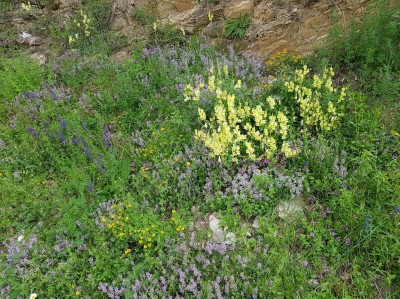
- Meadow flowers
But butterfly numbers were low. Small Pearl Bordered Fritillary (
Boloria selene) and Silver Studded Blue (
Plebejus argus) did show themselves well, and a good number of the group saw both Weaver’s Fritillary (
Boloria dia) and Almond Eyed Ringlet (
Erebia alberganus). Roger and I also spotted our first Turquoise Blue (
Polyommatus dorylus) of the week, always a lovely species to see.
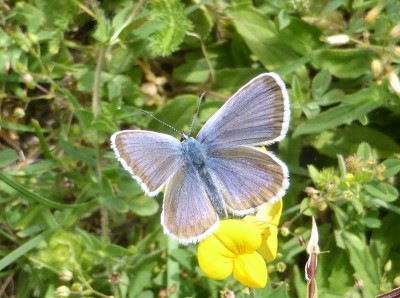
- Silver Studded Blue
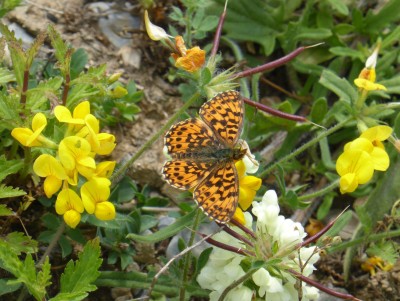
- Weaver's Fritillary
We had lunch at the precise spot a Scarce Fritillary had been seen the previous year, but despite a few spells of sunshine, we had no luck, and we left the site strongly suspecting that this species hadn’t yet emerged this year.
Our last stop for the day was down the valley from our hotel. The meadows here, by the river, are stunning, especially with the mountains in the background. The weather forecast for the afternoon was poor, but actually it turned out to be sunny when we arrived. This was fortuitous, and we were able to get some excellent photos of Duke of Burgundy (
Hamearis lucina) and Geranium Argus (
Aricia eumedon). Again, both were mint fresh. The latter species was seen almost exclusively on Geranium, of course!
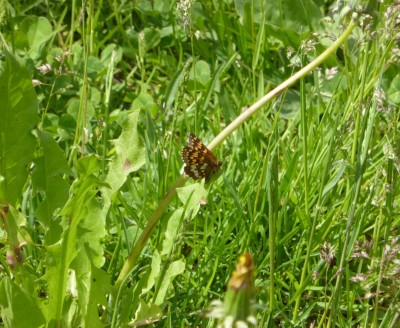
- Duke of Burgundy
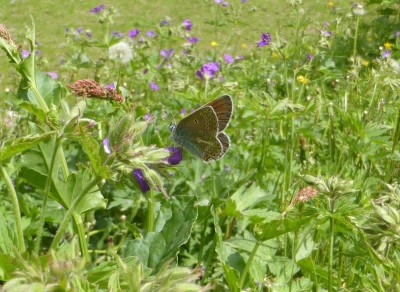
- Geranium Argus
Also putting on a good display were Clouded Apollo (
Parnassius mnemosyne). Such was the behaviour of all the individuals we saw, it felt like they had only emerged that afternoon. This gave us all a great opportunity for close range photos.
Despite the mixed weather, and the disappointment about missing out on Scarce Fritillary, we all agreed it had been a good first proper day. Four of us had a celebratory swim in the geothermally heated hotel swimming pool, before sitting down for the daily checklist, and then dinner.
The hotel owner, Franco, told us that evening that he’d never known a worse Spring for weather in his life. No wonder butterfly numbers were low, and we were seeing such late emergences!